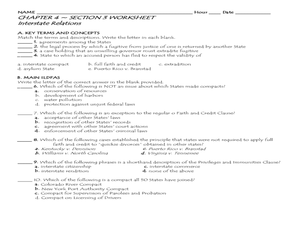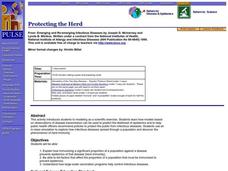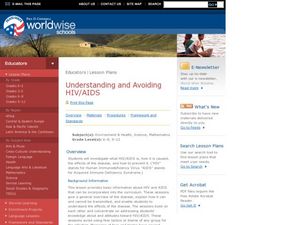Curated OER
Your Body's Defenses When Microbes Attack
Students study how being exposed to a harmful microbe doesn't automatically make them ill. They discover the lines of defense against microbe invaders and explore the roles of skin and mucus membranes, white blood cells, and lymphocytes...
Curated OER
Interstate Relations
Your class might be clear on how the federal government relates to states, but what about how states relate to each other? Challenge your students with this worksheet, which could function as a review activity or as a quiz. Questions...
Curated OER
COMPARISON OF FOUR-, SIX-, AND EIGHT-bp CUTS IN CALF THYMUS DNA
Students use this laboratory exercise, restriction enzymes to recognize a four-, six-, and eight-nucleotide sequence. Assuming that the four component nucleotides (A, C, T, G) are distributed randomly within a DNA molecule, then any...
Curated OER
Blood: Transport and Protection
In this blood instructional activity, high schoolers review what makes up blood: plasma, platelets, and red and white blood cells. Students also learn how the blood helps fight viruses, bacteria, and other foreign substances. This...
Curated OER
Water Microbes and Human Health Exercise
In this water microbes and human health worksheet, students complete a crossword puzzle given 11 clues about different water born illnesses caused by microbes.
Curated OER
Making Vaccines
Students discuss the steps the American government has taken in order to protect every U.S. citizen from a bioterrorist attack and how a vaccine works. After discussion, students can create six vaccines in their own virtual laboratory.
Curated OER
Medical Terminology - Blood, Lymph, Immunity
In this medical word search worksheet, students identify and locate vocabulary terms related to specific medical terminology. There are 54 words located in the puzzle.
Curated OER
GED Vocabulary: Life Science
In this GED life science worksheet, students complete a crossword puzzle given 8 clues about cell division, genetics, and the human body systems.
Curated OER
Why Does My Body Smell?
Fourth graders investigate how germs spread among people. In this health lesson, 4th graders discover the causes of infection and proper hygiene methods.
American Museum of Natural History
What Do You Know About the Human Microbiome?
Scholars answer 10 multiple choice questions to test their knowledge about the human body and microbes. Correct answers come with a rewarding tone and brief description.
Rice University
Biology for AP® Courses
An eight-unit electronic textbook provides a guide to AP® Biology. Each of the 28 chapters include an introduction, multiple lessons, a summary, review questions, and test prep questions. Teachers see how each lesson connects to a big...
Curated OER
Protecting the Herd
Students explain how immunizing a significant proportion of a population against a disease prevents epidemics of the disease (herd immunity). They list factors that affect the proportion of a population that must be immunized to prevent...
Curated OER
Health & Wellness
Students examine the need for proper immunizations, good nutrition, and other safety concerns.
Curated OER
A Pox No Longer Upon Us
Tenth graders research the development and use of vaccines. They examine historical documents for qualitative observations and the basis of immunization. They examine primary and secondary immune responses as they relate to the...
Curated OER
Understanding and Avoiding HIV/AIDS
High schoolers begin the lesson by discussing what they already know about their immune system. In groups, they participate in a true and false game using the facts and myths of HIV/AIDS. They discuss how the disease is affecting their...
Curated OER
Antibodies
Students conduct a series of exploration activity on how vaccines and antibodies work. In this biology lesson, students test how antigens and antibodies work in the body. They discuss the benefits of vaccines in promoting immune responses.
Curated OER
Body Battles!
Seventh graders explain the role of white blood cells in fighting infections. In this life science lesson, 7th graders create flow charts showing the immune response process. They act out and play a game to simulate actions of the immune...
Curated OER
Blood
In this blood worksheet, students complete a crossword puzzle given 24 clues about the components of the blood, the cells of the blood and the immune system with its antigens and antibodies found in the blood.
Curated OER
Molecular Recognition and the Immune Response
Students explore the importance of molecular shape and charge in molecular-recognition. They examine the interaction between antigens and antibodies. Students design and build 3-D visual models to represent molecular-recognition...
National Association of School Nurses
Learn to Be Smart and Safe with Medicine
Begin educating young people on how to be smart and safe with medicine. Use a set of workbook pages to explore what symptoms are, uses for medications, how to read prescription and over-the-counter medicine labels, and who to trust when...
Exploratorium
Antibody Attack - Discover How Antibodies Launch Attacks on Invaders
Jump into the action and help antibodies defend against an antigen attack! Investigators match antibodies with antigens to model the body's identification and recall of specific pathogens. Young biologists also recognize that each...
Prezi
Virus Cell Life Cycle/Structure
Viruses were nano before it was cool to be nano. The presentation covers the structure of a virus cell and the life cycle of a virus. It also includes two videos illustrating the virus cell in greater detail.
Concord Consortium
3D Exploration of Bound Antibody and Antigen
Our body manufactures antibodies that are the exact shape for the antigens it encounters. The simulation shows a 3-D model of an antibody and antigen pairing. It allows young scientists to explore the complementary shapes.
Howard Hughes Medical Institute
Viral DNA Integration
How do viruses hijack our cells to produce more viral particles? Junior immunologists model how viral RNA integrates into a host cell's DNA using pop beads and use interactive tools to explore a virus' genome. The teacher's guide...

























